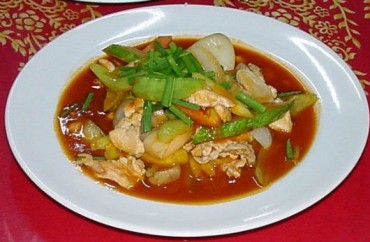
Having grown up two blocks from both my middle and high school, I didn’t have to deal with cafeteria food for my entire adolescence. I just walked home to make whatever I wanted for lunch.
That freedom ended abruptly in college. Seattle Pacific University required all underclassmen to buy meal plans, so along with the pasta bar and passable cook-to-order burgers, I experienced my first “Thai” food.
Those scare quotes indicate that I learned in retrospect the sad-looking chicken drenched in a bland peanut sauce (also new to me) sitting atop white rice was not the same Thai food I’d experience years later when I went to a Thai restaurant not paid for by my meal plan.
But because it was labeled “Thai” and I had only experienced butchered American versions of anything remotely foreign (outside a two-week trip to Chile, then the safest place in South America), I decided quickly that I didn’t like Thai, much less anything ascribed to another country, and never ordered it again in the cafeteria.
Pity the French Cajuns, too
This is only on my mind because of the Oberlin College food fight (as The Atlantic called it, obviously) and the rather clever use of social-justice language to spur quick action on a perennial college complaint: the food sucks.
You’ve read their complaints: The banh mi (an inherent cultural appropriation!) is made with ciabatta, pulled pork and slaw; there’s no weekly fried chicken; the rice in the sushi is undercooked and the fish isn’t “fresh.”
You could call them ingrates, because a soulless college food supplier is at least trying to “diversify students’ options in taste and flavor profile,” as The Oberlin Review put it.
Or you could blame the college for trying to satisfy every student’s whim and thus creating unrealistic culinary expectations, as some readers told The Atlantic‘s Conor Friedersdorf when he asked past and present Oberlin community members to explain what was going on. (Friedersdorf himself, “the grandson of two French Cajuns,” said he suffered through atrocious “gumbo” and “jambalaya” in college.)
Some of his readers actually suggest that the griping students are themselves guilty of racism and classism, because guess who is serving the food and who bears the brunt of their gripes:
As a teenager, I worked in the food service area of the college. The staff members were overwhelmingly black. I doubt that’s changed. How dare these privileged college snobs complain about food prepared by oppressed minorities? …
When I worked in the dining halls, employees were either students on work study or adults from the community. Most of these adults were low-income African Americans …
There’s something I find deeply irritating about mostly privileged students whining about how the dining hall staff isn’t preparing the sushi with the same reverence as a Japanese chef. …
I worked in a college cafeteria. The people who prepare the food are trying to get through their shift. They are assembling pre-packaged ingredients according to standard protocols. They are quite uninterested in who eats the food, or how they feel about it, or even if they like it. There is no scheme to appropriate culture. They are indifferent to culture.
America bastardizes whatever the market requires
But back to my experience with Thai food. I used scare quotes in the headline to refer to “real” Thai food because, um, we’re in America, where the vast majority of people eating Thai food are not of Thai descent.
The first Thai I ate outside the dining hall was at a Thai restaurant near the school on Queen Anne Hill, a privileged bastion of upper-class whiteness (sound familiar, Oberlin?) portrayed hilariously in the satirical novel Where’d You Go, Bernadette?
The dish was almost certainly cashew chicken, because I love nuts. I kept ordering it for years. It’s not authentically Thai:
Thai Cashew Chicken is one of many stir fry recipes that came to Thailand via the Chinese. Very popular in Thai restaurants …
Unless the menu tells me, I have practically no idea in any Thai restaurant whether what I’m ordering has the slightest resemblance to something that people in Thailand actually eat (probably lots more seafood than I eat). Unless Yelp reviewers tell me, I’m in the dark as to whether any given Thai place is substantially authentic, whatever that means.
When my wife (second-generation Chinese) cooked me her version of curry for the first time, I nearly passed out from the heat. She has loaded up the coconut milk every time since. She inevitably orders much spicier food whenever she’s not cooking for us.
I’m pretty sure any Thai restaurant you patronize that’s full of white people has made similar compromises with authenticity. And that’s simply because their bottom line depends on it.
Students who are ethnic minorities at Oberlin, unfortunately, have to deal with being food minorities as well. The cafeteria can probably only serve food that meets their standards by depriving a much larger group of students the cuisine that is familiar to them.
There’s really only one solution: Put an authentic bubble-tea stand in the campus convenience store. Everyone likes that.
Unless the tapioca pearls are too squishy. Then it’s not authentic.
Like The College Fix on Facebook / Follow us on Twitter
IMAGE: Tom Jutte/Flickr







Please join the conversation about our stories on Facebook, Twitter, Instagram, Reddit, MeWe, Rumble, Gab, Minds and Gettr.